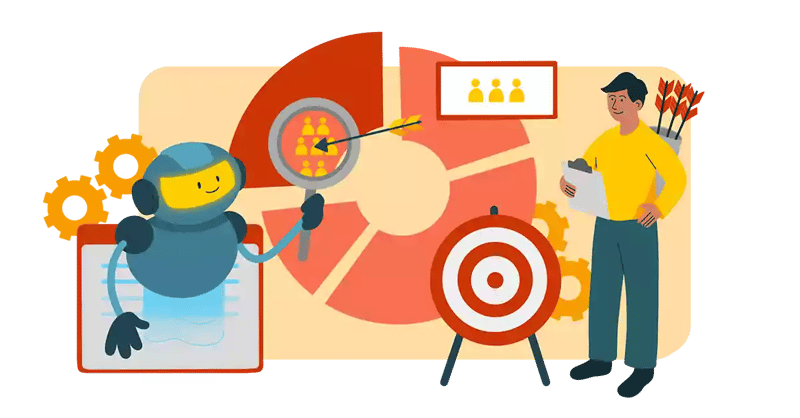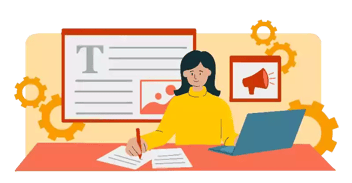la chiave del successo Inbound Marketing.
Quella pubblicità in cui vi imbattete sempre mentre consultate i siti web di notizie? Quella che mostra l'accessorio da cucina che avete acquistato online la settimana scorsa? Ebbene, questa è la dimostrazione più evidente di ciò che stiamo studiando: l'offerta di marketing personalizzato.

Perché l'esperienza del cliente inbound è importante?
Ci sono molti dati sui clienti a sostegno di feedback positivi, maggiore soddisfazione e maggiore fedeltà quando si tratta di servizi personalizzati lungo il percorso del cliente:
-
Il 90% dei clienti è disposto a pagare di più per un'esperienza cliente migliore. Investirenell'esperienza personalizzata del cliente può portare a un aumento delle vendite e dei ricavi.
-
L'80% degli acquirenti B2B inizia il proprio processo di acquisto con una ricerca su Google. L'ottimizzazione del sito web e dei contenuti per i motori di ricerca è fondamentale per garantire che i potenziali clienti possano trovare i vostri prodotti o servizi durante le ricerche online.
-
L'80% dei consumatori è più propenso ad acquistare da un marchio che offre esperienze personalizzate: Questo sottolinea l'immenso potenziale della personalizzazione. Il vostro pubblico di riferimento cerca attivamente e premia i marchi che rispondono alle sue esigenze. (Epsilon, 2023)
-
Il 71% dei consumatori trova frustranti i contenuti irrilevanti: Bombardare le persone con messaggi generici si ritorce contro. I contenuti personalizzati dimostrano che comprendete le loro esigenze, creando fiducia e fedeltà. (Salesforce, 2023)
-
Il 70% degli acquirenti è più propenso a fare affari con un'azienda che offre esperienze personalizzate. Raccogliere e utilizzare i loro dati è fondamentale per fornire ai clienti un'esperienza unica e memorabile. Questa può andare da e-mail personalizzate a raccomandazioni di prodotti su misura o a un servizio clienti eccezionale.
-
Le aziende che si concentrano sull'esperienza del cliente ottengono una redditività superiore del 60%: il legame tra personalizzazione e fatturato è innegabile. L'investimento in un approccio incentrato sul cliente favorisce la crescita dei profitti, il che lo rende un'attività utile. (Gruppo Aberdeen, 2023)
-
Il 59% dei marketer B2B registra un aumento dei tassi di conversione con contenuti personalizzati: La personalizzazione non è solo per il B2C. La personalizzazione dei contenuti in base alle esigenze e ai punti dolenti specifici dell'azienda produce risultati tangibili, spingendo i clienti verso la conversione. (Rapporto Demand Gen, 2023)
-
I clienti che hanno vissuto un'esperienza positiva hanno il 52% di probabilità in più di raccomandare il vostro marchio ad altri. L'esperienza dei clienti con il vostro marchio influenza in modo significativo la vostra reputazione e il modo in cui le persone diffondono la vostra azienda.
-
Il costo medio di acquisizione di un nuovo cliente è da 5 a 25 volte superiore a quello di mantenimento di un cliente esistente. Concentrarsi sulla soddisfazione dei clienti esistenti è molto più conveniente che acquisirne costantemente di nuovi.
- Le campagne e-mail personalizzate generano tassi di risposta sei volte superiori: L'e-mail rimane un potente strumento di marketing e la personalizzazione ne libera il pieno potenziale. Parlare direttamente agli interessi individuali aumenta il coinvolgimento e le azioni (Campaign Monitor, 2023).
Una strategia di Inbound Marketing di successo è piena di opportunità per personalizzare e creare contenuti personalizzati su più canali per colpire il vostro target in modo più mirato e rafforzare la loro fiducia nel vostro messaggio e nella vostra azienda. Dalle e-mail che si rivolgono al cliente per nome agli annunci pubblicitari come quello discusso nell'introduzione, fino alle pagine web personalizzate che appaiono per i diversi visitatori della vostra homepage e all'esperienza personalizzata del servizio clienti con una nota di anniversario. Tutte queste sono aspettative fondamentali dell'Inbound Marketing e sono ora possibili grazie alle tecniche di Inbound Marketing e alle soluzioni di automazione.
Tutto inizia con la conoscenza del vostro pubblico di riferimento, del profilo del cliente ideale e del buyer persona.
Iniziate con la vostra lista di e-mail di sottoscrizione
Un "frutto basso" del marketing personalizzato è la vostra lista di e-mail. Si dà il caso che sia anche uno degli strumenti più potenti del vostro arsenale per far sì che i clienti potenziali ed esistenti sentano un legame con il vostro marchio. Il punto di partenza è la personalizzazione della vostra newsletter opt-in.
Vi hanno dato i loro dati, non abusate di questa fiducia.
Quando parliamo di opt-in email marketing, ci riferiamo all'utilizzo delle informazioni di contatto che i visitatori del sito vi hanno fornito in cambio dell'accesso a contenuti riservati, all'elenco di iscritti all'ultima convention a cui avete partecipato e a qualsiasi altro potenziale cliente che vi ha fornito volontariamente il proprio indirizzo email. Questo dimostra un livello di fiducia tra il cliente e la vostra azienda che dovete coltivare e dimostrare di rispettare.
Per farlo, NON inondate la vostra lista di email con newsletter banali, offerte che non si applicano a metà della vostra lista o altri contenuti generici. Segmentate la vostra lista filtrandola in base a dati demografici, geografici o qualsiasi altro parametro offerto dal vostro CMS. Ora avete gruppi di nicchia più piccoli che possono essere facilmente indirizzati con offerte più specifiche, aggiornamenti sul settore a cui sono interessati e così via. I vantaggi della segmentazione e della personalizzazione del marketing sono molteplici:
-
Tassi di apertura più elevati
-
Tassi di clic più elevati
-
Tassi di conversione più elevati
tanto per cominciare. Questo metodo vi permette anche di inviare un numero minore di e-mail, riducendo drasticamente le spese generali. E come bonus, potreste anche assistere a una diminuzione delle richieste di annullamento dell'iscrizione, perché le persone vedono solo i contenuti delle e-mail che si applicano direttamente a loro.
Aprite le vostre e-mail nel cuore della notte?
Le soluzioni di automazione delle e-mail di marketing (e ce ne sono molte tra cui scegliere) consentono anche di programmare l'invio di ogni messaggio segmentato. In questo modo, le vostre liste di Londra e Los Angeles riceveranno la newsletter giusto in tempo per il caffè del mattino, invece di perdersi nell'inondazione della casella di posta del lunedì mattina.
Questo livello di personalizzazione è facile da realizzare, ma dimostra ai vostri abbonati che vi preoccupate veramente di loro e della loro cultura e che manterrete questo livello di fiducia in tutte le vostre interazioni. Anche il fatto che il campo Da mostri il nome di una persona, e non un generico indirizzo e-mail "No_Reply", è fondamentale. Utilizzate il responsabile del vostro reparto o il CMO; assicuratevi però di chiedere prima il permesso e di non utilizzare il loro vero indirizzo e-mail come indirizzo di ritorno!
Per essere sicuri che i vostri sforzi di email marketing stiano funzionando, fate un controllo incrociato con la nostra lista di controllo GRATUITA sull'email marketing:
Rivolgetevi ai visitatori che hanno già scaricato i contenuti
Alcune persone nel vostro database CRM saranno presenti perché hanno richiesto l'accesso a contenuti riservati. Questo è un segmento già pronto. Utilizzate il vostro strumento di automazione per inviare un'e-mail di follow-up una settimana dopo la richiesta iniziale, con ulteriori link ad approfondimenti degli stessi argomenti, promemoria dei prossimi webinar, ecc.
Utilizzate appieno i cookie del vostro sito web
Prestando molta attenzione alle norme e ai regolamenti che stabiliscono come possono essere utilizzate le informazioni di tracciamento (come il GDPR in Europa), gli strumenti CMS come WordPress e Hubspot Content Hub offrono modi potenti per personalizzare l'esperienza dei visitatori del sito. È possibile impostare CTA personalizzate per i visitatori, in modo da indirizzarli verso contenuti che non hanno già o che riguardano l'ultima cosa su cui hanno fatto clic.
È anche possibile personalizzare intere pagine del sito. Analogamente, Hubspot offre "contenuti intelligenti" che ruotano tra le opzioni preimpostate in base ai parametri impostati dall'utente e attivati dal cookie lasciato l'ultima volta che la persona ha visitato il sito. Queste pagine possono anche salutare la persona per nome (se avete anche i suoi dati di contatto nel vostro CRM) e mostrare contenuti personalizzati in base agli interessi precedentemente espressi.
Posizione, posizione, posizione
Il geo-fencing è una tecnologia che consente ai produttori di app di indirizzare gli utenti di smartphone con offerte, annunci e contenuti specifici per la loro posizione. Utilizzando il localizzatore GPS dello smartphone dell'utente, la vostra app può inviare un avviso push ogni volta che l'utente si trova nei pressi di uno dei vostri punti vendita con offerte di coupon o quando arriva in un luogo in cui avete uno stand per una convention. Non è una sorpresa quando Canada Goose mi invia raccomandazioni personalizzate con un'e-mail con outfit da neve quando le previsioni di neve sono all'orizzonte. Un ottimo esempio di utilizzo dei dati per personalizzare l'esperienza del cliente e parlare a ogni cliente come a un cliente individuale.
Il retargeting permette di personalizzare gli annunci che un cliente vede
Ricordiamo l'esempio iniziale, ovvero l'annuncio pubblicitario di un accessorio per widget che si vede su più siti. Questo è un esempio di retargeting. Il retargeting è un modo per ricordare alle persone che hanno visitato il vostro sito quanto lo hanno apprezzato e per invitarle a tornare a visitarlo per ricevere altri fantastici contenuti, offerte, ecc.
Utilizzando i cookie di tracciamento di cui sopra, il retargeting consente a visitatori specifici di vedere annunci specifici ogni volta che visitano un sito che partecipa alla rete pubblicitaria di retargeting a cui appartenete. Questa tecnica aumenta il riconoscimento e il ricordo del marchio e ricorda ai clienti la qualità delle vostre offerte. Inoltre, li incoraggia a ricordare quanto il vostro prodotto sia vantaggioso per loro e a tornare per averne ancora.
I servizi di inbound marketing offrono molti modi per personalizzare e adattare l'esperienza dei clienti quando fanno affari con voi o visitano il vostro sito web. Il punto è che le persone si fidano delle persone.
Supponiamo che riusciate a entrare in contatto con un potenziale cliente o a rinnovare il rapporto con uno già esistente attraverso esperienze personalizzate come quelle discusse oggi. In questo caso, potete trasformare un cliente abituale in un sostenitore del marchio e in un cliente fidato a vita.
Questo contenuto è disponibile in:
- Tedesco: Personalisierte Kundenerfahrung: Ein Schlüssel im Inbound Marketing
- Inglese: Personalized Customer Experience: Key to Inbound Marketing Success
- Spagnolo: Experiencia personalizada: Éxito con Inbound Marketing.
- Francese: Expérience client personnalisée : Clé de succès en Inbound Marketing.
- Rumeno: Experiența client personalizată: Cheia succesului Inbound Marketing.
- Cinese: 个性化客户体验:入站营销成功的关键











Facci sapere cosa ne pensi.